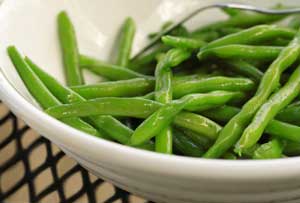Blanch
 |
Blanching is the precise process of briefly boiling or steaming foods. It effectively destroys bacteria and stops enzyme action, brightening raw foods for stir-fries, sides, and salads. |
Why Blanch?
Blanching destroys the enzymes that are responsible for decay and loss of color and flavor in foods. It is normally used for three reasons: to prepare foods for canning or freezing; to loosen the skins on nuts, fleshy fruits, and vegetables; and to crisp and enhance the color of fresh vegetables to serve raw or add to a stir-fry. It is the recommended way to store produce from the garden. Otherwise, fresh frozen vegetables and fruits will begin to break down in less than two months.
Technique Tips
• Use one gallon of water for each pound of food. Leafy vegetables are the exception. Double the amount of water to prevent bunching. Refill the pot as needed, but the water is reusable for additional boiling.
• Blanching begins when the food has been added to the pot and water returns to a full, rolling boil.
• The food must reach a temperature of 180ºF to stop enzyme action.
• Using a lid may cause some color loss in green vegetables, but helps maintain proper boiling temperature.
• When blanching in batches, all pieces should be uniform in size.
• Because the time from boil to cold immersion is crucial, a special lidded pot called a blancher may be useful. The basket allows for swift draining and transfer.
• Instead of cold bath immersion, it is acceptable to use running water for an equal amount of time.
• Be sure that food is free of moisture before freezing.
Timing Tips
• The general rule of thumb is equal amounts of time in boiling water and then in cold.
• Steam blanching is sometimes used, but requires additional time. This method reduces loss of nutrients.
• Blanching will take longer at 5,000 feet or more above sea level—add one minute to compensate.
• Exact timing is critical to blanching: too little or too much, and the food will be unappetizing or unusable. Here are some general guidelines to follow:
Artichoke hearts – 7 minutes.
Asparagus – 2 minutes (small)/3 minutes (medium)/4 minutes (large). Snap off tough end first.
Beans (with shells) – 2 minutes (small)/3 minutes (medium/4 minutes (large).





